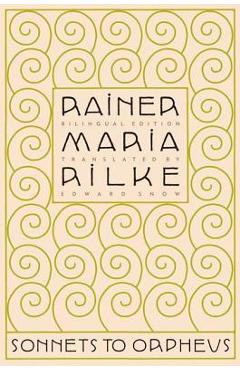Sonnets to Orpheus, Paperback/Rainer Maria Rilke

Detalii Sonnets to Orpheus, Paperback/Rainer Maria
elefant.ro
95.99 Lei
Foreign Books
Wesleyan University Press
Sonnets to Orpheus, Paperback/Rainer Maria - Disponibil la elefant.ro
Pe YEO găsești Sonnets to Orpheus, Paperback/Rainer Maria de la Wesleyan University Press, în categoria Foreign Books.
Indiferent de nevoile tale, Sonnets to Orpheus, Paperback/Rainer Maria Rilke din categoria Foreign Books îți poate aduce un echilibru perfect între calitate și preț, cu avantaje practice și moderne.
Preț: 95.99 Lei
Caracteristicile produsului Sonnets to Orpheus, Paperback/Rainer Maria
- Brand: Wesleyan University Press
- Categoria: Foreign Books
- Magazin: elefant.ro
- Ultima actualizare: 13-02-2022 23:21:30
Comandă Sonnets to Orpheus, Paperback/Rainer Maria Online, Simplu și Rapid
Prin intermediul platformei YEO, poți comanda Sonnets to Orpheus, Paperback/Rainer Maria de la elefant.ro rapid și în siguranță. Bucură-te de o experiență de cumpărături online optimizată și descoperă cele mai bune oferte actualizate constant.
Descriere magazin:
An accomplished poet\'s first and only sonnet sequence. Sonnets to Orpheus is Rainer Maria Rilke \'s first and only sonnet sequence. It is an undisputed masterpiece by one of the greatest modern poets, translated here by a master of translation, David Young. Rilke revived and transformed the traditional sonnet sequence in the Sonnets. Instead of centering on love for a particular person, as has many other sonneteers, he wrote an extended love poem to the world, celebrating such diverse things as mirrors, dogs, fruit, breathing, and childhood. Many of the sonnets are addressed to two recurrent figures: the god Orpheus (prototype of the poet) and a young dancer, whose death is treated elegiacally. These ecstatic and meditative lyric poems are a kind of manual on how to approach the world - how to understand and love it. David Young\'s is the first most sensitive of the translations of this work, superior to other translations in sound and sense. He captures Rilke\'s simple, concrete, and colloquial language, writing with a precision close to the original. About author(s): RAINER MARIA RILKE was born in Prague in 1875. After a motley education at military and business schools and at Prague\'s Charles University, he traveled in Europe, Russia, Egypt, and Tunsinia. In addition to Sonnets to Orpheus , Rilke\'s works include the Duino Elegies, The Book of Pictures, Poems from the Book of Hours, New Poems, and The Notebook of Malte Laurids Brigge. Rilke died in 1926.

Produse asemănătoare

Sonnets to Orpheus: A New Translation (Bilingual Edition) - Rainer Maria Rilke
![]() libris.ro
libris.ro
Actualizat in 28/10/2025
111.55 Lei

Sonnets to Orpheus and Duino Elegies - Rainer Maria Rilke
![]() libris.ro
libris.ro
Actualizat in 28/10/2025
74.32 Lei

In Praise of Mortality: Selections from Rainer Maria Rilke\'s Duino Elegies and Sonnets to Orpheus - Joanna Macy
![]() libris.ro
libris.ro
Actualizat in 28/10/2025
222.83 Lei
Produse marca Wesleyan University Press

Her Birth and Later Years. New and Collected Poems, 1971-2021, Paperback/Irena Klepfisz
![]() elefant.ro
elefant.ro
Actualizat in 28/10/2025
122.99 Lei







